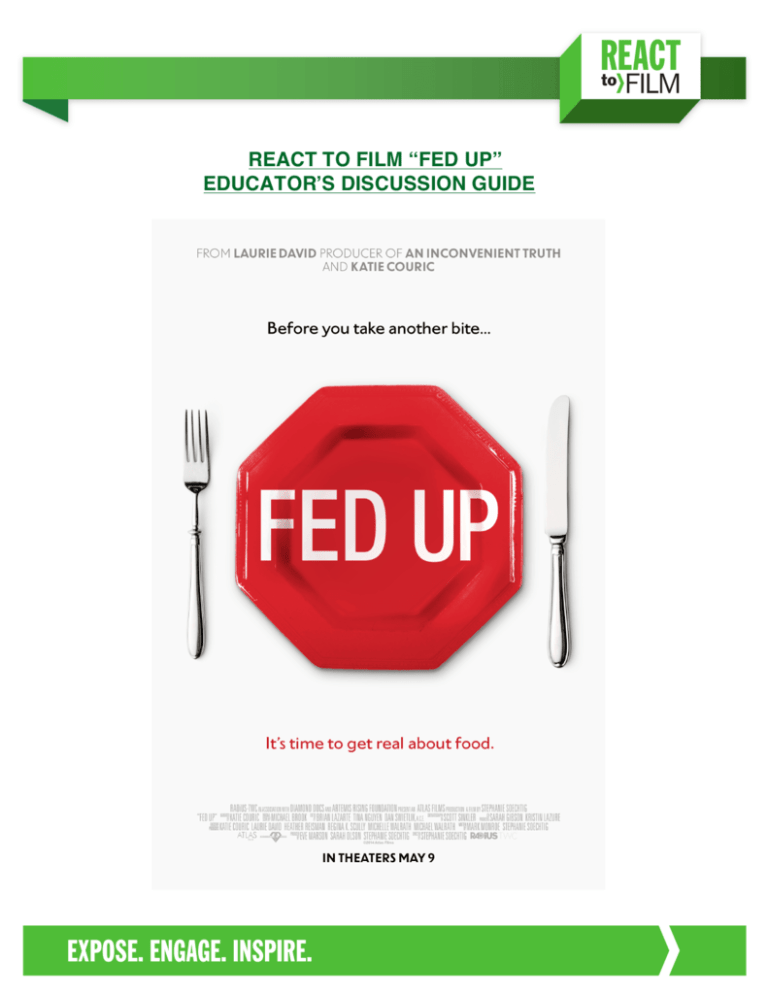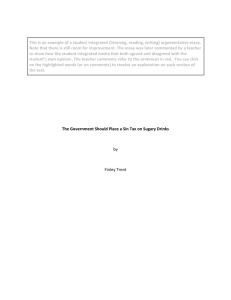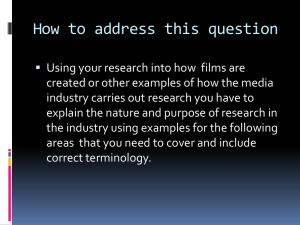REACT to FILM Fed Up Educator's Discussion Guide Final
advertisement

REACT TO FILM “FED UP” EDUCATORʼS DISCUSSION GUIDE STANDARDS & OPENING DISCUSSION COMMON CORE STATE STANDARDS INITIATIVE SL.9-10.2 Integrate multiple sources of information presented in diverse media or formats evaluating the credibility and accuracy for each source. SL.9-10.3 Evaluate a speakerʼs point of view, reasoning, and use of evidence and rhetoric, identifying any fallacious reasoning or exaggerated or distorted evidence. W.9-10.4 Produce clear and coherent writing in which the development, organization, and style are appropriate to task, purpose, and audience. SL.9-10.1c Propel conversations by posing and responding to questions that relate the current discussion to broader themes or larger ideas; actively incorporate others into the discussion; and clarify, verify, or challenge ideas and conclusions. SL.9-10.1d Respond thoughtfully to diverse perspectives, summarize points of agreement and disagreement, and, when warranted, qualify or justify their own views and understanding and make new connections in light of the evidence and reasoning presented. The Common Core State Standards listed above are for grades 9 and 10. However, you can reference www.CoreStandards.org to access standards for other grade levels. PRE-VIEWING DISCUSSION: Make sure to preface the viewing of the film with a brief discussion about safe-space and respect. It may be easy for students to become giggly or start feeling insecure when the topic is brought up. Therefore, itʼs important that students understand the purpose of watching the film. Ultimately, the purpose is for them to evaluate the different voices and perspectives in the film, determine their own opinions, and have a clear idea of ways in which they can improve their own health or the health of others through personal or social action. 2 VOCABULARY It may be a good idea to review some or all of these terms before viewing the film. You may want to revisit them during discussions that arise while the film is paused, as well as after the film as your class implements post-screening reaction activities. • Added Sugar: Sugars and syrups added to foods and beverages during processing • Diet: 1. The types of food that a person, animal, or community eats regularly as a form of habit 2. Restricting oneself to a special course of food for medical reasons or to lose weight • Processed foods: Commercially prepared food designed specifically for ease of consumption • Obesity: The condition of having excessive (too much) body fat. This condition increases risk of diseases and health problems such as heart disease, diabetes and high blood pressure. • Diabetes: A metabolic disease in which the bodyʼs inability to produce enough insulin causes higher levels of glucose (sugar) in the blood • Insulin - a protein hormone, secreted in the pancreas, that controls and regulates the amount of sugar in the blood by stimulating cells, especially liver and muscle cells. Insulin deficiency results in diabetes • Epidemic: A sudden, widespread occurrence of an undesirable phenomenon • Lobbyist: A person who is part of a group of people seeking to influence politicians or public officials on a particular issue • Special Interest Groups: A group of people seeking or receiving special advantages, often through political lobbying • Corporation: A company or group of people authorized to act as a single entity and recognized as such • Subsidy: A sum of money granted by the government or a public body to help an industry or business maintain low prices • Nanny State: The government seen as overprotective or as interfering with personal choice • Federal Trade Commission: A federal agency that administers antitrust and consumer protection legislation • McGovern Report - A report based on the proposition that people should eat less of harmful foods rather than more of foods that are good for them. The basis of most current guidelines on healthy eating. *Definitions adapted from Oxford Dictionaries, Mayo Clinic, and WebMD 3 TEACHER VERSION ACTIVE VIEWING GUIDE Provide a copy of the “Active Viewing Guide” to each student. Let them know that they will be held accountable for paying attention, and that this guide will help them to keep track of what they are learning, and how they are reacting as they go. Begin the film. Then pause at 3:15. Possible answers listed in italics. 1. Based on the introduction, what do you expect to learn from the film? Based on the introduction, you expect to learn about how obesity affects everyone either directly or indirectly. You can also expect to learn how the government, corporations, and the advertising industry are adding to the problem instead of the solution. Pause at 14:45. 2. Why is there a difference between 160 calories in almonds compared to 160 calories in soda? There is a difference between 160 calories in almonds compared to 160 calories in soda because it takes your body longer to process the almonds and less time to process the soda. Since soda has no fiber, it goes through your system so quickly that it increases blood sugar in the liver, which gets turned into fat immediately. Pause at 18:32. 3. Why did 20 doctors resign from the American Academy of Family Physicians? Twenty doctors resigned because they didnʼt like that the American Academy of Family Physicians partnered up with Coca-Cola. They didnʼt understand why an organization that promotes public health would partner up with an organization that creates products that put children at risk. It seems like Coca-Cola gave funds to prevent studies that show the truth about obesity from being published. 4. Why does the film compare sugary beverages to the tobacco industry? The film compares sugary beverages to the tobacco industry because the tobacco industry is know for advertising a product that ultimately causes cancer and leads to death, while the sugary beverage industry is doing something similar by promoting products which lead to obesity and can also ultimately lead to death. 4 Pause at 27:47. If students struggle with the question, you may want to replay the short 40-second clip from 27:04 through 27.47. 5. What happens to your body when you eat sugar? What are the after-effects? When you eat sugar, your blood sugar rises. When your liver is pushed to the max, your pancreas creates insulin. Insulin turns sugar into fat for storage. High levels of insulin keep your brain from getting the signal that youʼre full. So, your brain thinks you are starving, and you start to feel really tired. Pause at 41:23. 6. Are all “low fat” foods considered healthy? By labeling items as “low fat,” what did the food industry do to make the food still taste good? Who benefits from this labeling? Not all “low fat” foods are considered healthy. When the food industry started labeling items as “low fat,” they added sugar to make it still taste good. By labeling the food that way, the food industry and advertising industry benefit, while the consumer gets tricked into buying products that arenʼt actually healthier. 7. Why did the World Heath Organization decide to delete the sugar recommendation from reports? The World Health Organization decided to delete the sugar recommendation from reports because the sugar groups pushed back against the recommendation that sugar should be only 10% of the daily-recommended diet. The Bush Administration sent Tommy Thompson to threaten the World Health Organization, saying that the government would withhold funding if the report were published. Stop at the end of the film. 8. Some people worry that government is playing too big of a role in peopleʼs lives and therefore, shouldnʼt be responsible for decisions about what people eat. For example, the former Mayor, Michael Bloomberg, wanted to limit the sizes of sugary drinks in New York City. Do you think the government should step in and set limits, or leave it up to the public to decide what to consume? I think itʼs smart for the city to limit the size of sugary drinks. Even though that alone wonʼt make people healthy, it might make it become less of a norm for people to drink such large sodas. Since the government knows how sugar contributes to obesity, they should step in so that the healthcare costs donʼt keep rising. The government should place limits on the advertising industry. Or I think the government should stay out of it. The public should just be educated enough to make their own decisions about what to eat, but companies should be able to sell whatever size drinks they want. 5 9. What is the role of the advertising industry in marketing to children? Do you believe that the advertising around you impacts your own food decisions? Do you feel taken advantage of? The role of the advertising industry in marketing to children is huge. There are advertisements for fast food everywhere. I think that the advertising might impact my own decisions sometimes because if I always see french fries and burgers on billboards or on TV, it might make me crave those foods. I do feel taken advantage of because advertisers shouldnʼt keep trying to entice kids to eat whatʼs not good for them. Or I think the advertising industry doesnʼt impact children. I think kids know whatʼs not healthy and just choose to eat it anyway. I am smart enough to make my own decisions even if McDonaldʼs and Coca-Cola put advertising all over my neighborhood. So, I donʼt really feel taken advantage of. 10. Why do you think the filmmakers chose to include the cemetery so close to the end of the film? I think the filmmaker chose to include the cemetery so close to the end of the film to leave viewers with the seriousness of obesity, and remind them that it causes people to actually die. 11. What sort of foods does your school cafeteria provide? Are there healthy options? If so, what do you see that has improved? If not, what would you like to see added? Answers will vary. 12. How do you think you can improve your own diet? Answers will vary. 13. What do you think can be done to improve health at your school or in your community? Answers will vary. 14. Who is in charge of the meals at your school? List their names and contact information. What would you ask them to change about the school meals? Answers will vary. 6 SUGGESTED REACTION ACTIVITIES • HOW MUCH SUGAR IS IN A 16 OZ. BOTTLE OF COCA-COLA? 1. Take a bag of sugar and a teaspoon. Have a student volunteer measure out 11 teaspoons of sugar into a clear bowl or cup. 2. Use a funnel or bent sheet of paper to transfer the sugar into an empty 16 oz. bottle to give students a visual. 3. Discuss the amount of sugar in beverages that the class consumes. Ask each student if the visualization made them want to change their own beverage consumption choices. • CREATE A HEALTHY RECIPE COOKBOOK. 1. Each student will research and bring in a healthy recipe to contribute. 2. Students can write out neatly and illustrate around their recipe. 3. Recipes will be scanned and compiled into a PDF booklet that can be shared online and also printed. 4. Time permitting, students can cook the recipes and bring them in to try at a “healthy food potluck lunch.” They can vote on the winning recipe and present it to the school cafeteria to consider for the school lunch menu. Image Source: naturalhealthadvisory.com • START A COMMUNITY GARDEN on the schoolʼs premises with the idea that the produce grown will be used for healthy snacks and/or in the school cafeteria. 1. Reference the book “Edible Schoolyard” by Alice Waters and the website www.edibleschoolyard.org. 2. Once the garden has been implemented, celebrate the achievement with a garden party. Family members can be invited to see the garden, and students can serve healthy snacks, created from garden produce. 7 SUGGESTED REACTION ACTIVITIES • WRITE A LETTER TO THE PTA, SCHOOL PRINCIPAL, AND/OR HEAD OF THE SCHOOL LUNCH PROGRAM AT YOUR SCHOOL 1. Investigate to find out the current practices and decisions made by the key stakeholder(s) selected. 2. Voice your opinion about what needs to change in regard to school lunch. 3. Make your appeal specific, and back it up with clear evidence from the film or additional resources. 4. Notify REACT to FILM of your action and the results to have it amplified via social media! • KEEP A FOOD LOG FOR A WEEK 1. Students can keep a weekly food log, noting not only which items they have eaten, but also how much sugar is in each. 2. Students can brainstorm and list ideas of how to improve their food intake to reduce the daily amount of sugar in their diets. • FAMILY FOOD PANTRY REVIEW 1. Ask students to look at their own kitchen with a parent or guardian to discuss improvements that can be made to family grocery shopping to benefit everyoneʼs health. 2. Have students write up at least 3 behaviors or decisions they will change, either in terms of grocery shopping or in terms of food preparation. • CLASS DEBATE 1. Have students role-play as the pro nutrition and health side vs. the food and soda industry side. 2. Allow each group time to prepare their arguments, and establish class rules for the debate. 3. Guide students to discuss topics of food in schools, American diets, marketing tactics, etc. Contributors to this guide include: Megan McIntrye, Alliance for a Healthier Generation Emilie Gioia, The Edible Schoolyard Lynn Fredericks, The Family Cooks For more information about REACT to FILM or to bring the Media Literacy and Civic Engagement elective course to your Middle or High School, please visit www.reacttofilm.com/educate. 8





